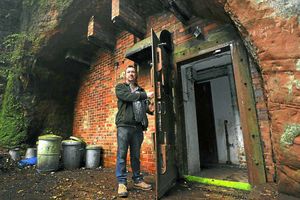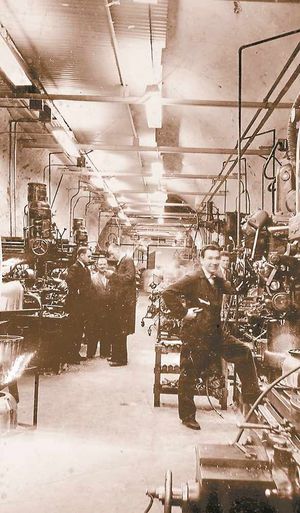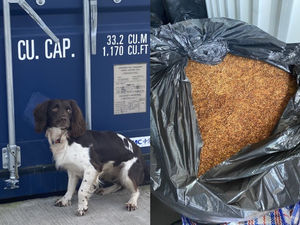Historic Drakelow Tunnels reveal their past
[gallery] A tree-lined rural track bordered on either side by sandstone rock is the unassuming entrance to a vast underground complex which was once the centre of vital military operations.

Drakelow Tunnels were used to manufacture machine parts during the Second World War and was designated a regional seat of government in the event of nuclear attack during the Cold War.
And the 285,000sq ft network of tunnels is still full of reminders of its military past from electrical vehicles used to move components to kitchen equipment once used by staff.
Plans are now in place to transform the tunnels, between Kinver and Wolverley, into a museum honouring the site's past.
The scheme has yet to be approved by Wyre Forest District Council.
And before any work is carried out, site caretaker Sid Robinson has thrown open the heavy metal door to the complex, north of Kidderminster, to give a glimpse of what is inside.
The first sight is a security booth which would once have been manned to ensure only authorised personnel could gain access to the complex.
Mr Robinson, 43, who has overseen the site since the early 1990s, said under the new plans the booth would be restored to its original appearance.
Another little-seen part of the complex is the sickbay where staff and occupants would have been treated. Basins can still be seen standing in the room.

Under the new museum plan a window will be fitted to the room and actors will perform an operation from the period on a screen.
This will show visitors the kind of medical treatment people using the tunnels could have expected. In the event of a nuclear war, doctors, surgeons and dentists would have operated from the room.
But one of the most chilling parts of the site is the BBC Room.
This is where, in the event of nuclear attack, radio messages would have been broadcast telling people what was happening.
A control desk from the period is still in place along with telephones from both the 1960s and early 1980s.
And other broadcast equipment from the period has also been donated for the museum scheme.
Mr Robinson said: "It is chilling to think someone would have sat here and reported what was going on if a nuclear war had taken place."
Large areas of the tunnels have been opened up into walkways. These would have originally been taken up by offices, but these structures have since collapsed and been cleared away.
When the tunnels were used as a factory during the Second World War around 600 people would have worked at the site.
And a kitchen from the 1940s, including vats and serving areas, is still in existence, although it is in need of restoration.
And nearby is a rusted electrical vehicle which would have been used to transport machine parts around the complex.
Mr Robinson said: "The interest in the site and its history has always been very high and the museum will allow people to learn more about the tunnels.
"Most of the feedback we have received has been positive and in an ideal world we would hope to have the museum up and running by late next year.
"However, the first thing will be to connect the tunnels to a permanent electrical supply and to remove the damp which has already caused some damage to the materials inside.
"Ideally we want this to be an additional tourist attraction adding to nearby Kinver Edge and the Severn Valley Railway."
Mr Robinson said they would welcome help from anyone who could provide period equipment to serve as exhibits in the museum. Under the new plans for the site, submitted by owners Quercus Ilex SA, a visitor centre would also be built nearby.
There are also proposals for six houses which would generate cash to fund work on the museum.
And the scheme is designed to be phase one of planned improvements for the site.
Once the museum has been established there are also proposals for nature walks giving better access to the listed Baxter Monument and views over the escarpment where the tunnels are built.
The Baxter Monument is an obelisk which was built in the mid-19th century by William Hancock in honour of 17th century preacher Richard Baxter. There are also plans to restore a series of rock houses at the site which are near to the tunnel entrances.
Mr Robinson said: "There are a lot of plans for the site. The aim is to bring the tunnels and the surrounding area back into use. It is such a shame to have buildings and tunnels of such historic interest which are not being used in some way.
"There is a great deal of work to be done before the tunnels are ready and we are always on the look out for people who can donate equipment to us for exhibits."
Mr Robinson said other parts of the work would be to de-humidify the tunnels and to remove some of the debris from where former officers had deteriorated over the years. The tunnels were excavated during the Second World War and used to manufacture machinery to be used in the conflict.
The tunnels were designed by Sir Alexander Gibb and Partners and were excavated from the sandstone hills during the conflict.
It was designed to be a factory for the Rover company, who were manufacturing engines for use in the war effort at the time.
It was intended to supply components to the firm's main shadow factories at Acocks Green and Solihull, to supply spare parts, and to act as a backup facility if either of the main shadow factories was damaged by enemy action.
Construction work began in June 1941 and was expected to take around a year to complete. In the event full production did not start at the complex until May 1943. It cost more than £1 million to complete.
The tunnels stretch for around three miles.
During the 1950s, the site was initially used by the Ministry of Supply for storage.
It was developed by the Home Office as a Regional Seat of Government in the late 1950s.
Modernisation of the tunnels took place during the 1980s, with a lot of original equipment is still in place to the present day.
New blast doors were fitted in place of the previous wooden factory doors and the interior of the site was refurbished in some areas.
The site was decommissioned during the early 1990s and sold.
Over the years there have been a number of tours around sections of the complex but firm plans for the site have never been put in place.
A scheme to turn the site into a residential and commercial park years ago was met with opposition amid fears the original tunnels could be lost.
Mr Robinson said: "The aim of these plans are to retain the tunnels and highlight their historic importance to the area," he said.
"This will be making use of their long and fascinating history."





